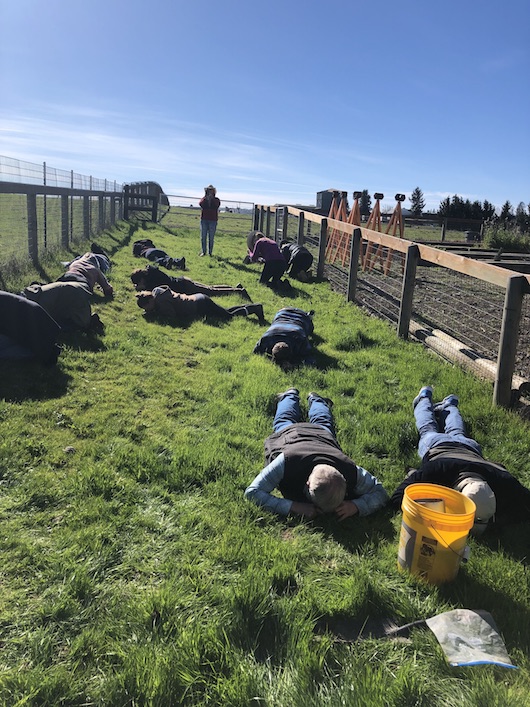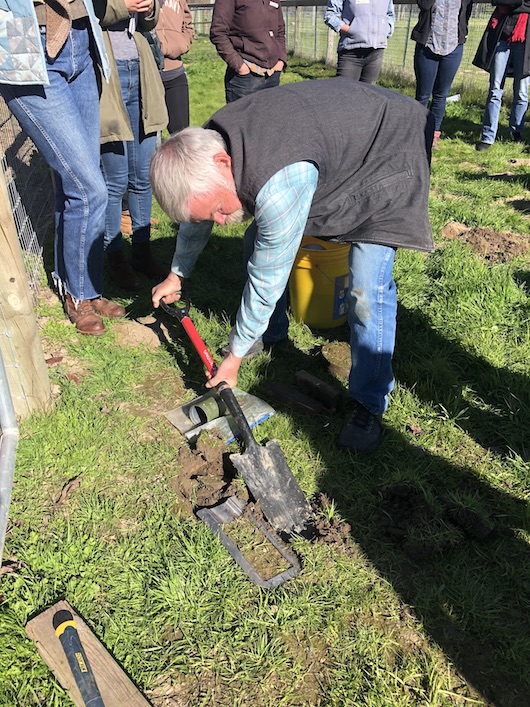
Everyone get down and take a closer look at our soil!
Spring is just about sprung here in the Capay Valley and that means school groups and tours will be arriving soon! When groups come to visit, we always ask them the question “Do you know what we grow here at Full Belly Farm?” And of course, the answers are always wide-ranging: “tomatoes, flowers, carrots, chickens, lettuce!” While all of these answers are correct, visitors tend to forget two of the most important things: soil and conscious farmers!
Without healthy, rich, and nutritious soil we would never be able to grow such healthy, rich and nutritious crops! We care for our soil by spreading compost, grazing our land with sheep and chickens, and even experimenting with reduced-till crop rotations to care for the billions of organisms underneath our feet. And what about conscious farmers? We open our farm to dedicated and caring interns every year to teach them these same practices. Also, we can’t forget the school groups that will be arriving on our door any day now. Experiences like these have the possibility of growing future conscious farmers for the world.
The interns get to be a part of every process of soil building throughout the year, but as the Education Director, how can I share these rich experiences in just a few hours with student groups? Last week I was lucky enough to attend a Land Listener Workshop, led by Richard King and Peter Donovan (the founder of the Soil Carbon Coalition) that helped me to think about how to answer that question.
Located at a beautiful pasture in Petaluma, I worked alongside directors of regional Resource Conservation Districts (RCD’s) from all over California, as well as local ranchers from the area, to stop and really look at soil carefully. Peter handed us small magnifying glasses, and invited us to lie on our bellies, look into the soil, and share what we saw. Together we were able to explore how what is below us is not just dirt, but fascinating systems that are all in communication with each other. “The land is telling us a story all the time… and we have to listen,” Richard explained.

Taking a Soil Sample
As part of the workshop we also took small soil tests by hammering a stainless steel cylinder into the ground, creating a secured sample area, and timing how long it took for water to soak into the ground. Peter chose different areas of the pasture that had experienced different cycles of use: a recently grazed field, a commonly used walking path, and a pasture that had time to mature. We compared the amount of time each area was able to absorb water giving us different data points about soil absorption. This might not come as a surprise for some of you, but some compacted areas were unable to absorb water for several hours!

Comparing soil infiltration rates
As our state continues to fight more fires and more draughts, it leaves many farmers wondering: How do we store our water? Is it through dams? Large plastic containers? It seems as though one answer lies directly under our feet. What if we were able to store water where we’ll need it most? What about in the soil?
Many educators will tell you, it is best to allow someone to experience and see how a process works, rather than solely tell students about it. What better way to learn than by experience! This workshop allowed me to experience ways of interacting with and seeing firsthand the importance of healthy, functioning soil. I’m so excited to share what I’ve learned with our upcoming visitors and to help to continue to promote and grow conscious farmers.
You can find more information and free resources from Richard and Peter’s work and if you’d like to find out more at Full Belly for yourself, please feel free to contact me to schedule a visit at the farm and play with some dirt!
— Sierra Reading
Full Belly Farm Education Director
